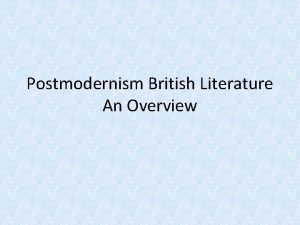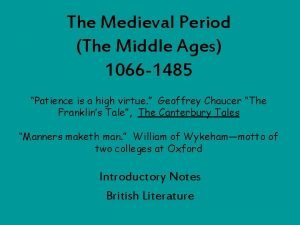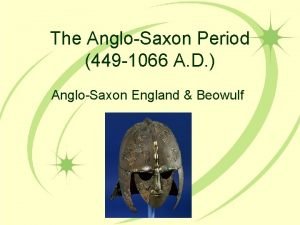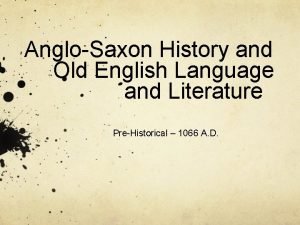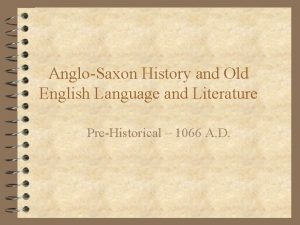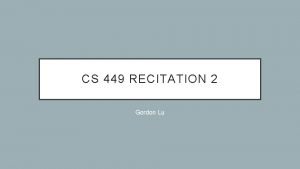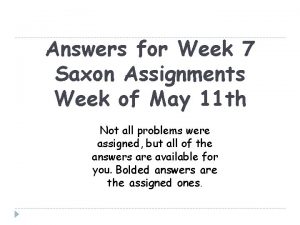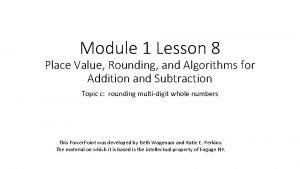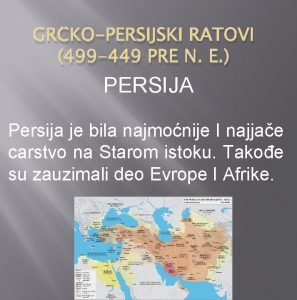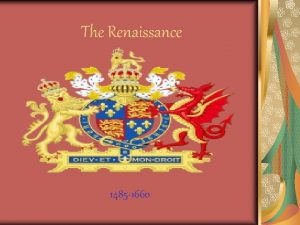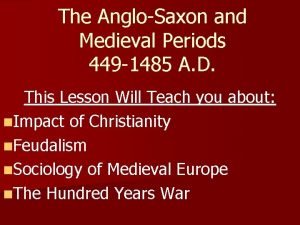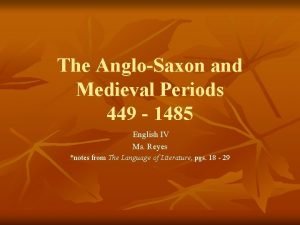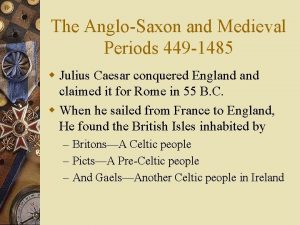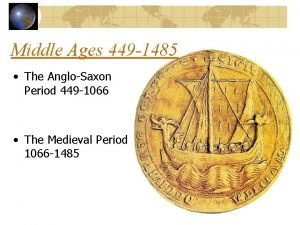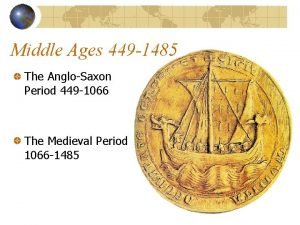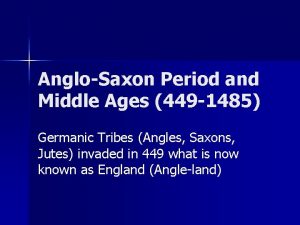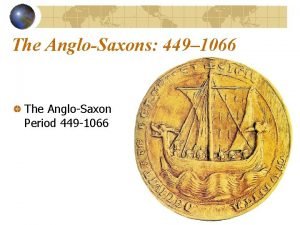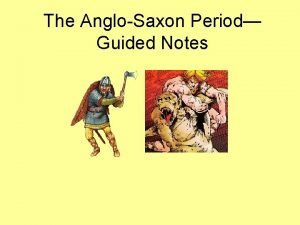The AngloSaxon Medieval Periods 449 1485 The Language












- Slides: 12

The Anglo-Saxon & Medieval Periods 449 -1485 The Language of Literature – British Literature copy right 2006 by Mc. Dougal Littell Inc. All rights reserved. Intro Unit 1 Part 1 – Tests of Courage Part 2 – Reflections of Everyday Life Part 3 – Attempts at Perfection In reading great literature, I become a thousand men and yet remain myself. ~ C. S. Lewis novelist & essayist

Objectives Understand the following literary terms: • Epic • Stock Epithet • Kenning • Caesura • Identify alliteration and appreciate its effects • Make judgments about Beowulf as an epic • Recognize theme – tests of courage • Recognize shared characteristics of cultures through reading • Recognize themes across cultures

Tests of Courage The Anglo-Saxon and medieval periods were ones of turmoil and change – times when peoples courage was frequently put to the test. Amid this turmoil, the tests of courage often took the form of physical challenges, such as confronting a dreaded foe or battling to survive on the high seas. Other tests of courage involved spiritual or emotional challenges, such as standing up for one’s religious beliefs or enduring the absence of a loved one. As we read this part of Unit One, try to place yourself in the distant past and imagine how you would respond to similar challenges. http: //www. silenceopensdoors. com/tag/grendel/

The Epic • An epic is a long narrative poem that celebrates a hero’s deed. The earliest epic tales survived for centuries as oral traditions before they were written down. • They came into existence as spoken words and were retold by poet after poet from one generation to the next. • Most orally composed epics date back to preliterate periods – before the cultures that produced them had developed written forms of language. • Many epics are based on historical fact, so that their public performance by poets (known in different cultures by such names as scops and bards) bards provided both entertainment and education for the audience.

The Epic • One characteristic feature of oral poetry is the repetition of certain words, phrases, or even lines. Two of the most notable examples of repeated elements are stock epithets and kennings • Stock epithets are adjectives that point out special traits of particular persons or things. In Homer, stock epithets are often compound adjectives, such as the “swift-footed” used to describe Achilles. • Kennings are poetic synonyms found in Germanic poems, such as the Anglo-Saxon epic Beowulf. Rather than being an adjective, a kenning is a descriptive phrase or compound word that substitutes for a noun. For example, in Beowulf “the Almighty’s enemy” and “sin-stained demon” are two kennings that are used in place of Grendel’s name.

Literary Analysis Alliteration is the repetition of consonant sounds at the beginning of words. Poets frequently use alliteration to emphasize particular words or images, heighten moods, or create musical effects. In words of the oral tradition, alliteration was also used to aid memorization. In his, translation of Beowulf, Burton Raffel has used alliteration to suggest the sound and style of the Old English poem. The ancient blade broke, bit into The monster’s skin, drew blood… Look for other examples of alliteration as you read the excerpts from Beowulf.

Literary Analysis Old English poetry has a strong rhythm, with each line divided into two parts by a pause, called a caesura. In the Old English text printed here, the caesuras are indicated by extra space in the lines. In his translation, Burton Raffel has often used punctuation to reproduce the effect of the caesuras. Old English version ða com of more under misthleoþum Grendel gongan, godes yrre bær; mynte se manscaða manna cynnes sumne besyrwan in sele þam hean. Modern English version Out from the marsh , from the foot of misty Hills and bogs, bearing God’s hatred, Grendel came, hoping to kill Anyone he could trap on this trip to high Herot.

CHARACTERISTICS OF THE EPIC Epics from different languages and time periods do not always have the same characteristics. Kennings, for example, are not found in Homer’s epics. However the following characteristics are shared by most epics, whether they were composed orally or in writing. The hero’s… • generally a male, is of noble birth or high position and often of great historical or legendary importance • traits reflect important ideals of his society • performs courageous – sometimes even superhuman – deeds that reflect the values of the era. • The actions of the hero often determine the fate of a nation or group of people. • The setting is in vast scope, often involving more than one nation. • The poet uses formal diction and a serious tone. • Major characters often deliver long, formal speeches. • The plot is complicated by supernatural beings or events and may involve a long and dangerous journey. • The poem reflects timeless values, such as courage and honor. • The poem treats universal themes, such as good and evil or life and death.

The Birth of the Beowulf Epic After the fall of the Western Roman Empire to Germanic tribes in the 5 th century A. D. , Europe entered a period of political unrest and economic and cultural decline. Many groups of Germanic speaking tribes (Angles, Saxons and Jutes) abandoned their homes due to the unrest and settled on the island of Britain, where they established what is now called Anglo-Saxon civilization. Their famous tale of the great hero Beowulf takes place on the European mainland, among two related tribes, the Danes of what is now Denmark, and the Geats of what is now Sweden.

The Birth of the Beowulf Epic Beowulf is a Geat warrior who crosses the sea to aid the Danes and later returns to Sweden to succeed his uncle Hygelac (the Higlac of this translation) as king of the Geats. Although we cannot be sure Beowulf ever really lived, we do know that Hygelac was a historical figure who led a military raid some time around the year 525. The action of Beowulf is presumably set not long afterward. 500 A. D. Europe http: //www. firstboynton. com/2011/07/01/ear ly-middle-ages-500 -1000 -barbarians-thepapacy/

The Birth of the Beowulf Epic At the time, Germanic societies had not adopted Christianity. Their warrior culture celebrated loyalty and deeds of great strength and courage. For entertainment, people gathered in mead halls (bars) where they drank and listened to tales of heroic achievements. These tales were presented both in the form of epic poems and in shorter verse narratives. Poet-singers called scops in Anglo-Saxon society—recited the poems in a chanting voice, usually accompanying themselves on a harp. http: //misswealhtheow. blogspot. com/2009/05/folklore-of-southwest. html

Beowulf Each night for 12 years, the monster Grendel has come out of the darkness to terrorize the Danes. Beowulf, a young prince of the Geats, travels to the Danish shore and offers to kill Grendel with his bare hands. The Danish king Hrothgar gratefully accepts. …And so the epic tale begins. http: //www. freemoviedb. com/wa tch/8402/beowulf__grendel. html
 British literary movements
British literary movements Middle english period 1066-1500
Middle english period 1066-1500 Anglo saxons alphabet
Anglo saxons alphabet Anglosaxon history
Anglosaxon history Anglosaxon period
Anglosaxon period Cpsc 449
Cpsc 449 Davies v waldron (1989) vr 449
Davies v waldron (1989) vr 449 Cs 449
Cs 449 Cs 449
Cs 449 The anglo-saxon period 449 to 1066 answers
The anglo-saxon period 449 to 1066 answers Lesson 8 use place value to round numbers answer key
Lesson 8 use place value to round numbers answer key Posledice grcko-persijskih ratova
Posledice grcko-persijskih ratova The renaissance 1485-1660
The renaissance 1485-1660
